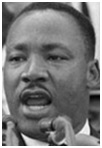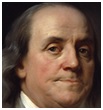|
 |
|
 |
|
|
||
The American Declaration of Independence - Success and Happiness
The American Declaration of Independence (1776)
What it looked like...
This is John Trumbull's famous 1819 painting of the historic event:
Famous for...
1. Its emphasis on individual rights and government by consent This is stated in its second sentence that begins: “ We hold these truths to be self-evident, that all men are created equal, that they are endowed by their Creator with certain unalienable Rights, that among these are Life, Liberty and the pursuit of Happiness.- - That to secure these rights, Governments are instituted among Men, deriving their just powers from the consent of the governed”.
2. Its support of revolution against unjust British colonial rule (the
American Revolutionary War) The war began in 1775 and America’s victory in 1783 gave it independence. This was caused by American fury at being taxed without their approval (taxation without representation), leading to the famous Boston Tea Party on December 16, 1773 - the dumping of tea in Boston harbour in protest against the British tea tax.
3. Thomas Jefferson Jefferson (pictured right above) wrote it except for a few amendments by:
4. Independence Day The day that the Declaration was ratified by Congress (4th July) is a public holiday in America and a day of great celebration.
5. The American Constitution This was ratified in 1788 and founded upon the principles of the Declaration of Independence. 6. Abraham Lincoln Lincoln (pictured right in 1863) used the Declaration of Independence to justify the North’s fight against slavery in the American Civil War. “Four score and seven years ago our fathers brought forth on this continent a new nation, conceived in liberty, and dedicated to the proposition that all men are created equal”, he said in his Gettysburg Address in 1863.
Lessons for success and happiness
1. Everyone has equal rights Minority groups and the weak can’t be exploited because: “all men [and women!] are created equal”. The interpretation of this phrase led to the American Civil War, because President Abraham Lincoln believed this gave equal rights to
black slaves as well as whites. Martin Luther King referred to black equality in his ‘I have a dream’ speech in 1963 (pictured right): King said: I have a dream that one day this nation will rise up and live out the true meaning of its creed: “We hold these truths to be self-evident, that all men are created equal”, Jefferson also wanted to make blacks and whites equal, but (much to his anger) Congress (led by South Carolina and Georgia) removed his anti-slavery clause from the Declaration.
2. You can’t do anything without people’s consent This was also referred to by Lincoln in his Gettysburg Address in 1863 (pictured right): “Government of the people by the people, for the people shall not perish from the earth”. This raises a possible conflict between:
This conflict creates what the English philosopher, John Stuart Mill (pictured right), called the “tyranny of the majority”. So amendments to the American Constitution (starting with the Bill of Rights in 1791) have always guaranteed people’s rights like:
3. Philosophy is fundamental The English philosopher, John Locke (1632-1704), pictured right, had a great influence on Jefferson who called Locke the: “spiritual guide of the American Constitution”. Jefferson adopted Locke’s idea that everyone is born equal with certain natural (or
unalienable, as it says in the Declaration) rights that can’t be taken away by the
government. Tom Paine’s (pictured right) best selling pamphlet, Common Sense, published in January 1776 was also extremely influential. It supported:
4. Love change The Declaration and the War of Independence were a tremendous risk for Americans, particularly wealthy ones
like:
But they knew this was the only way to:
This need for revolutionary change was summed up by Patrick Henry in 1775: “Give me liberty, or give me death!”
5. Policy based upon principles American ideals (as specified in the Declaration) are the unchanging foundation upon which government policy is built. They include:
Jefferson thought that happiness wasn't just for the individual but for the community and country as well. People must strive for individual excellence for the good of others.
Key quotes
We hold these truths to be sacred and undeniable that all men are created equal and independent - Thomas Jefferson, pictured right (from his original draft of the Declaration).
Taxation without representation is tyranny. - James Otis, pictured right (which became the rallying cry of the American Revolution).
The Revolution was in the minds and hearts of the people. - John Adams, pictured right (the second American president).
Let us raise a standard to which the wise and honest can repair. The event is in the hand of God. - George Washington, pictured right (in
1787 at the Constitutional Convention that agreed the American Constitution). |
|
|
||
|
|
||
| Copyright © wisdomtowin.com 2025 All Rights Reserved | ||
|
















